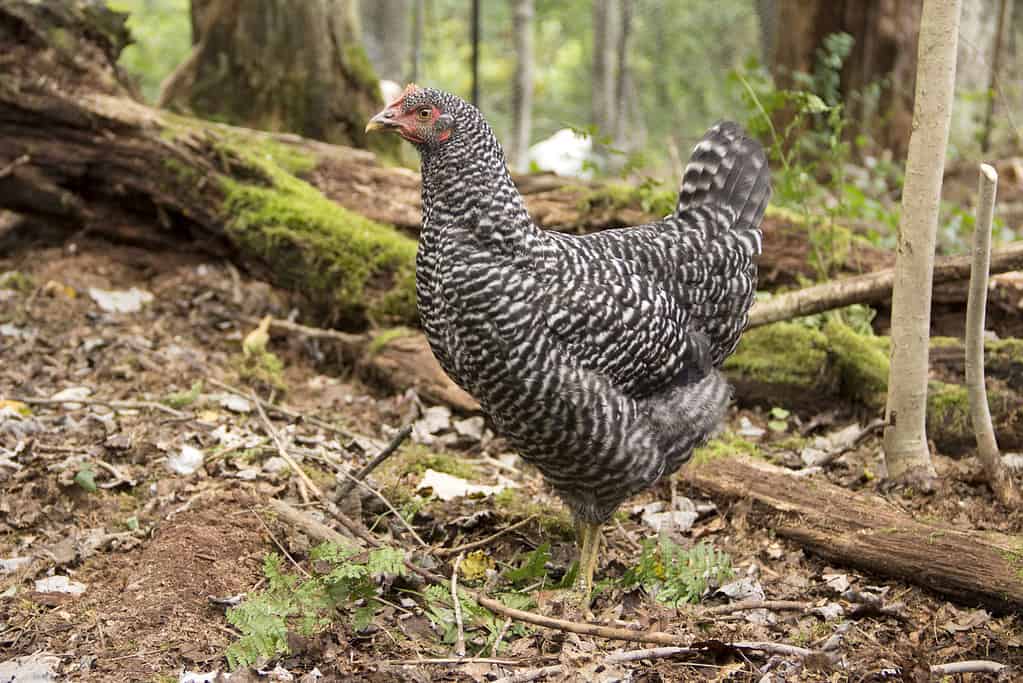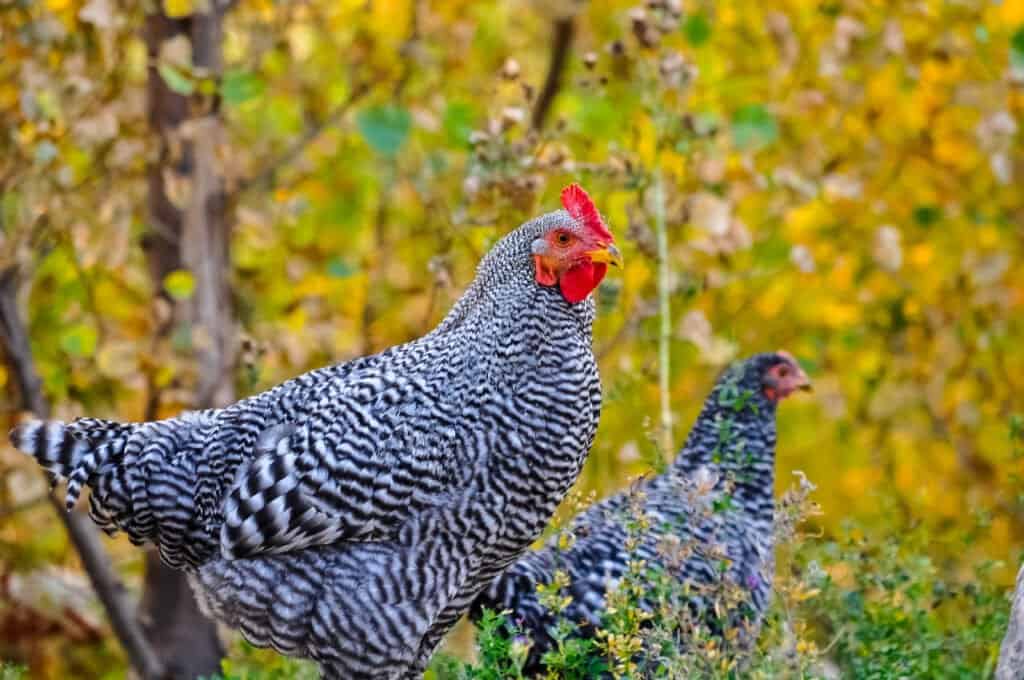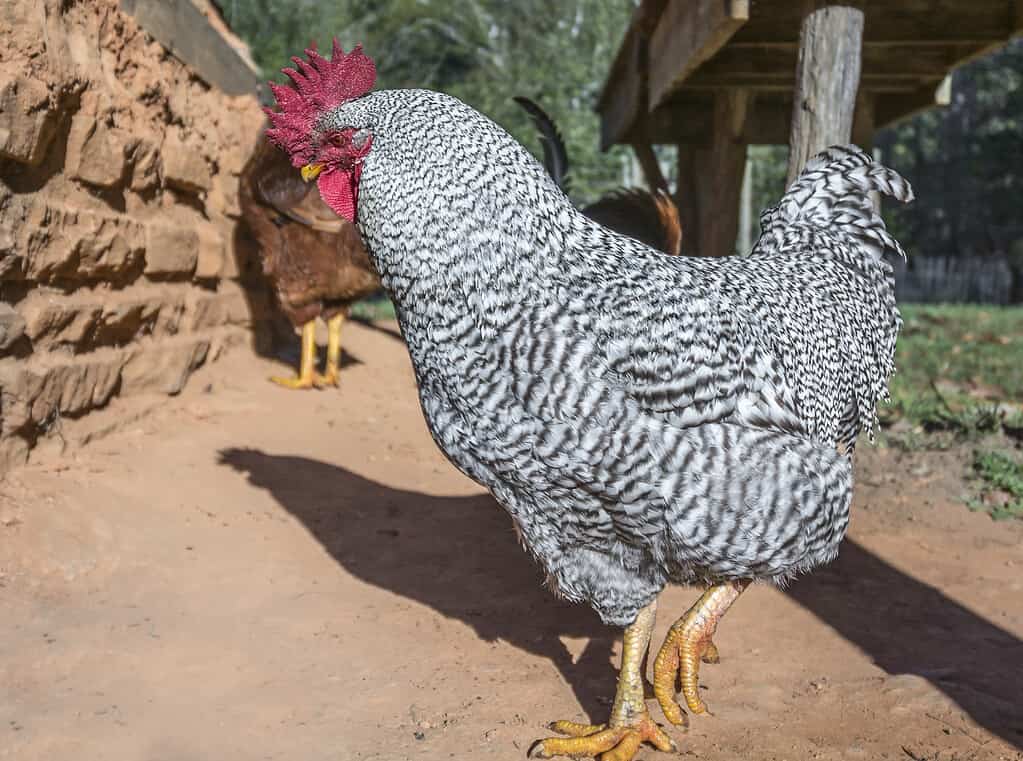The roller coaster history of the Plymouth Rock chicken is a survival story going back roughly 200 years. This breed, developed in the United States, had its first official showing in Massachusetts in 1849. It seemed to vanish entirely until 20 years later, after the Civil War, when it popped up again at another show in 1869. This dual-purpose breed then took off, rising in popularity as both a high-quality meat bird and a prodigious egg producer.
Plymouth Rock chickens had a place in practically every flock in America throughout World War II, helping to bolster the food supply at home and support the war effort. But afterward, their popularity declined as other breeds outperformed their production in the commercial egg industry. Their numbers plummeted and their future looked bleak, but thanks to conservation efforts the Livestock Conservancy officially removed this breed from its Conservation Priority List in 2023. Now, let’s take a closer look at the Plymouth Rock chicken and learn the differences between the hen and the rooster.
Plymouth Rock Hen vs. Rooster: Shape
Both Plymouth Rock hens and roosters have full and robust bodies. They have a somewhat triangular shape with a long, broad back and a deep, full breast. Their relatively short necks and tails add to their triangular appearance. They have an upright stance with their heads held erect. Roosters, especially, have tails with a perky, uplifted appearance.

Plymouth Rock chickens have a roughly triangular shape with relatively short necks and tails.
©JZHunt/iStock via Getty Images
Plymouth Rock Hen vs. Rooster: Size
The Plymouth Rock chicken is a large-sized chicken breed. Their abundant feathers make them look even larger than they already are. Plymouth Rock hens reach approximately 7.5 pounds. Plymouth Rock roosters, when fully grown, weigh about 9 pounds. Bantam-sized Plymouth Rock chickens have much smaller bodies than their full-sized counterparts but are significantly larger than a lot of other bantam chickens. Bantam Plymouth Rock hens usually weigh about 32 ounces, while bantam Plymouth Rock roosters reach approximately 36 ounces.
Plymouth Rock Hen vs. Rooster: Plumage
Plymouth Rock chickens have soft and abundant feathers. Their feathers are especially soft and fluffy on the undersides of their bodies. Both hens and roosters have similar overall plumage, especially in the barred and solid color varieties. Roosters have longer hackle and saddle feathers. They also have sickle feathers which curve up and over their tails. These may include black feathers with a metallic sheen.

The barred variety of Plymouth Rock hens have even black and white bars on their feathers.
©Jennifer de Graaf/Shutterstock.com
Plymouth Rock Hen vs. Rooster: Color Patterns
The Plymouth Rock chicken is most recognized in the barred pattern. This pattern features feathers that have alternating black and white bars. Hens have a more even barring pattern, while roosters have wider white bars than black. The reason for this difference lies in the sex-linked gene responsible for the white bars. Barred Plymouth Rock roosters have two copies of this gene, while hens have only one, therefore roosters exhibit more white coloring than hens. Some other breeds also exhibit similar barred patterns, including Dominique chickens, cuckoo-patterned Marans chickens, and barred Cochin chickens.

Plymouth Rock roosters have more white than black in their bars due to a sex-linked gene.
©Mshake/iStock via Getty Images
The American Poultry Association recognizes a total of seven different color variations of the Plymouth Rock chicken in the large size and eight colors in the bantam size. Recognized feather patterns include the ever-popular barred, as well as partridge, silver penciled, and Columbian, and solid colors include white, blue, and buff. The bantam size is also recognized in black. European authorities recognize 10 different colors, while the British organization recognizes only five. All recognized colors except for barred and white are considered rare.
Plymouth Rock Hen vs. Rooster: Other Physical Characteristics
Plymouth Rock roosters have medium-sized, bright red, single combs with five points. They also have red faces and bright red wattles and earlobes. The Plymouth Rock rooster has a relatively short neck, as compared to many other breeds, and though their tail stands upright, the sickle feathers reach comparatively short lengths. They have strong, yellow, clean legs and feet with four toes.
Plymouth Rock hens also have bright red, single combs. They have small, bright red wattles, red earlobes, and red faces. Their combs and wattles, though smaller than those of the Plymouth Rock roosters, appear as large as those of some roosters of other breeds. Plymouth Rock hens have a very triangular body, with a long, broad back, relatively short neck, and short, slightly uplifted tail. Like the roosters, the hens also have yellow legs and feet with four toes.
Plymouth Rock Hen vs. Rooster: Temperament
Plymouth Rock chickens are generally friendly and calm birds. They get along exceptionally well with other breeds and with people, including children. They generally tolerate petting and handling, and they enjoy being around people. Their docile nature makes them ideal as pets or show birds. They enjoy foraging and ranging freely, and they do not fly well, so they are relatively easy to contain.
Plymouth Rock hens sometimes go broody, and they reportedly make very good mothers. Plymouth Rock roosters can behave somewhat aggressively when protecting their hens. This breed is relatively quiet, though talkative. Roosters sometimes crow loudly when being territorial.
Plymouth Rock Hen vs. Rooster: Egg and Meat Production
Plymouth Rock chickens were originally bred for both meat and egg production. The heritage form of the breed produced more meat and fewer eggs than the modern iteration, which breeders have selectively bred for egg production. Today, most Plymouth Rock hens lay about 200 large, brown eggs per year in their first three to four years of production. That averages about four eggs per week, which is quite a good rate. After about the fourth year, egg production begins to decline.
Plymouth Rock roosters grow to be about 9.5 pounds, which places them squarely among the larger breeds of chickens. The heritage variety grows even larger, reportedly reaching weights of 12 pounds or more. Plymouth Rocks were one of the earliest breeds of the broiler industry. They produce very tasty and juicy meat.
Plymouth Rock Hens vs. Roosters: A Summary
Here is a summary of the differences between Plymouth Rock hens and roosters. This breed expresses little sexual dimorphism in the most popular varieties. The roosters and hens have similar plumage, as well as similar body shapes and features such as bright red, single combs, red wattles, and yellow legs and feet. It can be very difficult to tell Plymouth Rock hens and roosters in the barred or solid color varieties apart in the beginning. Once their full plumage comes in, distinguishing one sex from the other becomes easier.
| Hens | Roosters | |
|---|---|---|
| Size | Up to 7.5 pounds | Up to 9.5 pounds |
| Plumage | Full and abundant, loosely held soft feathers; barred variety has more even bars than the rooster | Full and abundant, loosely held soft feathers; barred variety has whiter bars than the hen; some black feathers in tail |
| Other Traits | Medium-sized, bright red, single comb with clearly defined points; bright red wattles and red earlobes; yellow legs and feet | Medium-sized, bright red, single comb, larger than hen, with 5 points; bright red wattles and red earlobes; yellow legs and feet |
| Temperament | Friendly, calm, and docile; tend to go broody; very good mothers | Friendly, calm, and docile; generally not aggressive unless defending hens |
| Production | Large-sized, brown eggs; about 200 per year declining after about 4 years | Tasty and juicy meat; heritage varieties produce more |
The photo featured at the top of this post is ©
Thank you for reading! Have some feedback for us? Contact the AZ Animals editorial team.







